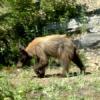Leaderboard
Popular Content
Showing content with the highest reputation on 02/10/2021 in all areas
-
Nothing short of a body is going to be taken as proof of their existence. How many times has inconclusive primate DNA or DNA that is almost human but not quite been discovered? It is good for a quick 'what if' moment on a tv show or documentary, and then it is just shelved. How many hairs have been found that did not seem to be from any known species? Any footage that isn't crystal clear is going to be met with calls of pareidolia or blobsquatch. Any clear footage will be immediately labeled as a hoax. I'm sorry, but if anyone thinks otherwise then I would assume that they haven't been paying attention to the last 40+ years of Bigfoot investigation. To prove the existence of something as earth shattering as Sasquatch, you need irrefutable, undeniable proof. You need a body. I am almost to the point of thinking that even a body part may not be enough. You need something that cannot be ignored or explained away...or covered up. An adult body at that, as I believe that a smaller juvenile could be explained away as an already classified primate that had somehow escaped captivity. Unlike a lot of people on here, I don't view these things as some sort of fuzzy forest friend or noble savage. I believe that they have regularly predated upon man in the past, and only the advent of firearms caused them to be more reclusive. I believe that they still prey upon humans as the opportunity allows. Either they are an extremely physically gifted apex predator which views us as extremely dangerous prey, or they are a sapient relic hominid that views us as direct competition...a competition that has caused them to live in secrecy for hundreds of years. So, basically they view and treat us as an enemy. Either way these things are not our friends, so I don't allow sentimentality to affect my judgement here. As far as being charged for killing one...we are talking about a huge predator that isn't supposed to exist. It would be like me killing a tiger in the woods of South Carolina. Sure, it's an endangered species. But, it's a loose tiger in an area where it is not supposed to exist. PETA might get upset, but no one else will. The only real problem that I have with the concept of pro-kill is the difficulties involved with taking the shot. From what I have seen, by the time you have 100% identified your target to eliminate the possibility of shooting a hoaxer or someone in a ghillie suit... you've probably lost your shot. You would have to take a shot at a distance on a target that has remained in view long enough to dispel any doubts. Even then I could see many people freeze on pulling the trigger because of that 1% chance that it is a human in a suit.4 points
-
You are simply wrong. Even if what you imply were true for the bulk of the continental US, the history of the timber industry is a red herring so far as implications about bigfoot in my area. In my state we have just over 2.5 million acres of land designated as federal wilderness ... never logged. Much of this lays along the spine of the Cascade range. While "broken" by narrow strips where major highways cross the range, much is functionally contiguous. (And, as if it should be any surprise, there are concentrations of reports along those highways.) The Coast Range is similar though less is federally protected. Southern Oregon's wild areas are contiguous with those in Northern California. Those in NE Oregon adjoin similar areas in SE Washington and Idaho. The NW piece of Oregon, and north Central, are contiguous with similar areas in southern Washington with only the Columbia river, I-84 and Washington route 14 separating them .. again, each having a significant number of road/river crossing sightings and trackways reported. This claim you make suggests you don't have a boots-on-the-ground feel for what you're talking about, no experience. Go out there. In person. Look around. Get away from the roads. See things for how they really are rather than how you imagine them to be. It is .. educational. You will see old clear cuts if you fly over, but look around them .. miles of forest. The bigger issue today, more important than past logging, is the recent history of large fires that have cut off potential travel routes in ways that logging never did. Statement of fact: there is plenty of room, plenty of opportunity for a creature over 5 pounds to remain undiscovered, particularly if it is a sapient creature willfully remaining undiscovered rather than accidentally remaining undiscovered. MIB3 points
-
Actually, I think that they are willing to admit that humans were here 30,000 years ago. They pushed it back a bit once the Clovis First lie was finally exposed enough that they could no longer sustain it. Seeing how the scientific community blackballed people for challenging Clovis First tells you all that you need to know about the possibility that there has been evidence covered up concerning Sasquatch. If evidence doesn't support the current narrative, it goes away and is ignored.2 points
-
The wilderness areas of the Pacific Northwest are vast. There is certainly enough habitat and food available to support a breeding population of large, omnivorous primates. British Columbia for instance has more square miles of wilderness than there are people living there. Most of the population in Canada are situated in settlements along the U.S. border. Beyond that is mostly wilderness. Much of which remains virtually unexplored to this very day. To suggest that a species yet unclassified by science could not remain hidden in the Pacific Northwest represents the pinnacle of hubris. More than 200 years of eyewitness accounts combined with many more centuries of Native American and First Nation legends suggest something is out there. It is in fact far more unlikely to assume that this entire phenomenon is the result of more than two centuries of hoaxing and misidentification than it is to suggest that North America is home to a breeding population of an as yet species of unclassified bipedal primate. Just my two cents worth.2 points
-
It looks like we have a new name for the white substance on the Bigfoot. Sasquatch Alba Vernix. Soon there will be a description on proper collection techniques. A good way to start 2021! See Doug Hajicek's post from 1/1/21 https://www.facebook.com/groups/BFRO.group/ https://www.olympicproject.com/from-monsterquest-producer-dough-hajicek-wanted-suspected-finger-grease-interview-coming-soon/ Shelly Covington-Montana from the Olympic Project1 point
-
They can’t be somewhere like that full time. As a rancher that buys hay and manages pasture on 350 acres? You would be utterly amazed what a 1000 lbs cow eats in one year. And what the land looks like as a result. You can’t hardly walk 20 feet without stepping in a cow pie. You start talking about a breeding population? Plus being mostly unseen, low impact on the land, very little scat, hair, etc? Just one nocturnal critter moving through? Sure. That Cougar that was killed on the road on the east coast was from South Dakota. No one reported a cougar from point A to B. It was DNA that told them where it came from. For 1500 miles that cat had to drink and eat. It did so undetected. A Bigfoot being a bipedal animal could walk from Alaska to Argentina. No problem believing that. But they don’t wear back packs full of food. It’s forced to live off the land as it goes..... It’s an 800 lbs creature. That’s a lot of groceries. The range of one Grizzly Bear (a fellow omnivore) is 600 square miles. That’s 384,000 acres. These things are not hiding out in a city park for half the year. They can’t. Its impossible.1 point
-
I've got an app for this question - out of 1,065 encounters reported in the northeast US and eastern Canada only 186 were on/near a road w/the Bigfoot either paralleling the road (58 encounters) or crossing the road (128 encounters if I can do math). Personally, I'm stunned at how small that number is, especially out east here where we're packed in like sardines. Only 26 encounters were were on/near (w/in 25 yards of) an electric or gas cut. I'm really stunned about that. 100 encounters were within a body of water. One caveat to these numbers (which I'm sure that people would realize when they think about it) is that if the report is too vague, you can't really get good information. For example, I couldn't estimate the distance from water in almost 250 reports. One of the nice things about Google Earth is that once you fix the likely location of an encounter you can more accurately identify how remote - or not - it was. When making reports it seems like humans think in human terms - the distance to the next town via road. But if you look at it from a Bigfoot perspective, the nearest population center, whether it be a town, a village, or a built up area out in the country might be a short walk away. Out of 1065 encounters in the northeast US/eastern Canada, 720 occurred within 3 miles or less of a reasonably large cluster of humans.1 point
-
I would note for the benefit of new members that you can find several excellent and fulsome threads on almost any topic, like this one, that you have questions about. I have to immediately add that I am among the worst people at figuring out how to find those topics. For instance, there was a robust discussion a few years back that also developed multiple offshoots as to what it would take to find and engage a Bigfoot target (tactical plan, weapons, logistics, etc.). I'm noting this to highlight the depth of information that's here even for the free side (and there's so much more if you become a premium member!) . Found the thread I was thinking about in spite of myself - 82 pages of kill/no kill debate can be found at .1 point
-
I wonder how you'd feel if you were to see one Norse, making you a knower, and then getting asked the question about them utilizing residential type areas with big populations such as areas of Cook County Il (Chicagoland) and Westmoreland County PA (East Pittsburgh Suburbs) ? I think they can and do inhabit areas that would blow our minds if we legitimately knew they were in x and y area, personally. How they do it, i have no idea, and i don't think they're necessarily there full time neither but there's a ridiculous number of reports from largely populated areas of North America and if you're a knower, then it changes the entire mentality about what they do and where they do it. Food for thought anyway.1 point
-
I agree, and a healthy degree of skepticism is certainly necessary. That was one of my biggest gripes with Finding Bigfoot, Moneymaker and crew saw Sasquatches behind every tree. The preponderance of the evidence does however suggest that an unclassified species of bipedal primate inhabits the wilderness areas of North America. If such a species exists, and the evidence suggests it probably does, than it is vital that the species is classified by science and placed on the endangered species list.1 point
-
Im not a knower. But I’ve always fought for the possibility of its existence. And I roll my eyes when people show me Bigfoot evidence from a small park in Chicago. But a large area in the US and Canada still remains for something like this to exist. Hopefully it will remain so for future generations to enjoy.1 point
-
Okay, distance/clarity check. First two are of a lighthouse with phone camera and phone camera with attached telephoto. The second two are of an island.1 point
-
Exactly. The argument that an unclassified species of megafauna couldn't exist in North America because it would have been found due to logging is absurd. Animals are mobile, they are not stationary like trees. Speaking of trees, a species of pine tree presumed extinct for 200 million years was recently discovered in a remote area of Australia. The tree is 115 feet tall. If an immobile species of tree can remain hidden from modern science, what does that say about an elusive and highly intelligent primate? http://www.wollemipine.com/faq.php#:~:text=The Wollemi Pine is one,outside Australia's largest city%2C Sydney.1 point
-
If Sasquatch exists, and the evidence suggests that they do, then they are likely very rare with a low population density. The BFRO estimates there are around 2,000 individuals inhabiting the wilderness areas of North America. If the species is ever formally classified by science, it will almost certainly be placed on the endangered species list. The question of whether or not a specimen should be killed and then given government protection is complicated with good arguments on both sides of the issue. On the one hand, killing a specimen would prove to be the quickest and most efficient method of proving the species existence to the satisfaction of skeptical scientists. On the other hand, the species is more than likely highly endangered, and killing a specimen could prove to have detrimental consequences for the future survival of the species. There is also the question of ethics. If the Sasquatch proves to be a hominid or type of human, then killing a specimen would constitute homicide. With all of these factors in consideration, I personally take a "No Kill" position. I would much rather get clear photographic or video evidence of a Sasquatch, then kill a specimen of what is almost certainly an endangered and very human like species. However, this does not mean that researchers in the field shouldn't take necessary precautions. If Missing 411 is any indication then Sasquatches are an apex predator and potentially very dangerous. I always go into the woods armed, but this is simply for defensive purposes. If a Sasquatch attacks I will open fire. But killing a specimen is not my objective.1 point
-
My whole push is to see if I can find a scientist who will listen up on that point. Because if this creature is out there then people ARE getting DNA from it. So the idea is to open someone's thinking enough, based on possibility, to take a closer look at samples that get brought in that say Human on the metabarcoding scale, but may show something else using a method that determines closely elated species. The issue with that is that when one does that then it means one needs to target for Human DNA in the environment which, by design, will disregard all of the other normal animals. If a scientist will do that then we may have a shot at seeing something very similar to Human but not Human. So you're right, Norseman, no one is routinely (or otherwise) testing only for primates, with Humans being the only target species one is sampling for.1 point
-
The weather report for Rochester, N.Y. calls for 18% grey. I am a Kodachrome guy, have a lot of slides in dark storage that are older than many forum members / visitors. Very few are aware that Kodachrome slides taken in 1937 look great. I have "Making Kodak Film Expanded Second Edition" by Robert L Shanebrook. Simply amazing.1 point
-
I hear ya. I've had communications with people from the Midwest who call what I'd refer to as a stand of trees as a forest and what I'd call a creek, they call a river. Our family cabin is about a mile outside a small town of pop. 200 and as you continue on the road past our cabin, it's 13 miles before you reach another road. I know by comparison that what BCWitness photographed is far more vast.1 point
-
Who is routinely testing for unknown primate DNA in North America? Who is digging past 20,000 years ago in the anthropology dept? Short answer? No one. Bigfoot is a myth. The narrative is clear.1 point
-
The forest is certainly amazing. There are many places for an elusive animal to hide that would make discovery difficult. My fiance and I are planning an excursion in northern Maine this summer. We are going to camp out for a few days and hopefully collect some evidence. I will keep everyone informed.1 point
-
All but one of my encounters happened within less than a mile from active logging sites.1 point
-
1 point
-
A species that large and mobile should be dropping DNA all over the place. Scientist that run biodiversity studies are either ignoring the sometimes odd data they're collecting, or they aren't getting any data. If some samples show primate DNA but it isn't from a Great Ape, as that would be pretty much impossible to find in North America, then the only alternative is Human DNA, right? It makes me wonder about the methodology being used. I really doubt that the type of sampling and testing can even distinguish the difference between two closely related species, like what Humans and Sasquatches are suspected to be. To make those kinds of distinctions, a completely different kind of protocol needs to be deployed. Scientists by and large usually cast a wide net in order to register as many different kinds of animals as possible. Like in the WA nests' samples. It was a metabarcoding protocol which picked up everything: bear, deer, elk, raccoon, birds, squirrels, etc. The problem, I have learned, is that if Humans and Sasquatches are closely related Like maybe 50% closer to us than Chimpanzees are) then metabarcoding might not be the method to use for showing BF existence. But it's still a method that almost every scientist uses. For example, a scientist might not use metabacoding to determine closely related lemmings living within a region, but it will tell a scientist that lemmings are present.1 point
-
Apologies to Johnny Lee, but it seems I was looking for Squatch in all the wrong places. I was lookin' for Squatch in all the wrong places Lookin' for Squatch in too many faces Searchin' their eyes, lookin' for traces Of what I'm dreamin' of Hopin' to find a primate and a hominid I'll bless the day I discover, Another Squatch- lookin' for love.1 point
-
I have listened to both of the "Sierra Sounds " cds many times. And we're talking probably 100 times each. What's fascinating to me is, at least in my opinion, those sounds would be impossible to fake. First and foremost, the vocalizations run the gamut of speech patterns and inflections. In the various recordings, the vocalizations contain phonemes, laughter, elements of exasperation, and the fact that there are at least 4 different sources of the vocalizations as well. You can clearly discern a very large, deep voice. A very feminine high pitched voice, and occasionally a very small voice. There is a part in the recordings where one of the hunters is mimicking one of the squatches. The squatch would whistle, or make some kind of vocalization, and the hunter would try to mimic it. At one point, clear as a bell, you can hear the squatch laughing at the hunter. The sounds were studied in the late 70's. The results were: there were at least 4 different subjects making the vocalizations. According to their findings, the deepest voice had a vocal tract of someone/something that was extraordinarily tall. I want to say they put the subject at around 8 ft. Also, they determined the whistles were made with the vocal chords, and not the pursing of lips (as humans do). The hunters believed the group consisted of "The Old Man", the deepest voice and probably the father. A female, the high pitched, feminine voice, and 2 younger ones. The first set of recordings were made in 1972. Those recordings were much more hostile sounding, and very rapid fire chimp like articulations. The second set of recording were made 2 years later in 1974, and the vocalizations were much slower, and had the sound of some sort of language. Also, the squatch in the first set of recordings was the "Old Man" in the second set of recordings. They believe the "Old Man" came back, with his family, and deliberately slowed down their vocalizations in an attempt to communicate in 1974. Look for interviews with R. Scott Nelson on this subject. In the late 2000's, his son was doing a book report on Bigfoot for school. They did a web search and came across snippets of the Sierra Sounds. Mr. Nelson is a retired Naval crypto linguist. He was trained to find coded messages in any kind of audio correspondence. Language played backwards, foreign languages played backwards, etc. He immediately identified the vocalizations as "Language as we define it". He obtained the original recordings from Ron Morehead, and had the necessary equipment to eliminate all the background noise, clean up the audio, etc. etc. Mr. Nelson said of the recordings, that again there were at least 4 different subjects, and in many instances they are talking over each other. They most definitely are speaking some kind of language as we define it. There were repeated phrases, and that they might even have names for one another. He's actually studied other recordings from various parts of the U.S., and found similarities in them. In one interview i heard, Mr. Nelson sent the recordings to a colleague in Japan that specialized in ancient Japanese dialects. His colleague contacted him and thought it was a very elaborate joke. When Mr. Nelson asked why, colleague responded with '" There are small bits of a Japanese dialect that no one has used in centuries in these recordings." Maybe the Samurai Chatter, as we call it, is just that. If you have not heard these, they are very much worth listening to. There's actually lots of other interesting things about the vocalizations, but this kind of touches on the high points.1 point
-
-1 points
-
Where did I say it was all logged at one time........maybe you should do a little research on the logging industry in the US, then maybe we could have a discussion after that. No we are not talking about Orangutans, do you want to talk about Orangutans, your kinda all over the place and we're definitely off topic. I would think the ramifications of nearly the whole continental US being logged multiple times would be obvious, as it relates to any undiscovered species.-1 points
-
Cool toys.....doesn't really seem relative but if you think that makes you an expert on logging industry in America...good for you! Where did I say anything about eradication of anything, due to logging? Where did I say anything about anything not existing because of logging? I'm not sure why you want to put words in my mouth, but I'd appreciate if you would stop, maybe buy less cool toys and do as I suggested to the OP and do a little research on logging in the US. Its ok to be wrong, but most embarrassing when you double down IMO.-1 points
This leaderboard is set to New York/GMT-05:00









